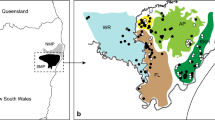Abstract
Quantifying dispersal, a fundamental biological process, is far from simple. Here, both direct and indirect methods were employed to estimate dispersal in an endangered butterfly species. A high and significant correlation between the dispersal patterns, generated by an inverse power function fitted to capture-mark-recapture (CMR) data on the one hand, and population genetic analyses on the other hand, was observed. Stepping-stone type movements were detected by both methods, evidence for the importance of connectivity in the studied metapopulation. These results are particularly relevant to those population and conservation biology studies where quantifying dispersal is essential for the elaboration of successful management actions.

Similar content being viewed by others
References
Akaike H (1973) Information theory as an extension of the maximum likelihood principle. In: Petrov BN, Csaki F (eds) Second international symposium on information theory. Akademiai Kiado, Budapest, pp 267–281
Baguette M (2003) Long distance movements and landscape occupancy in a metapopulation of the cranberry fritillary butterfly. Ecography 26:153–160
Beerli P, Felsenstein P (1999) Maximum likelihood estimation of migration rates and population numbers of two populations using a coalescent approach. Genetics 152:763–773
Bonnet E (2002) Zt: a software tool for simple and partial Mantel tests. J Stat Soft 7:1–12
Bossart JL, Prowell DP (1998) Genetic estimates of population structure and gene flow: limitations, lessons and new directions. Trends Ecol Evol 13:202–206
Cain ML, Milligan BG, Strand AE (2000) Long-distance seed dispersal in plant populations. Am J Bot 87:1217–1227
Clobert J, Danchin E, Dhondt AA, Nichols JD (2001) Dispersal. Oxford University Press, New York
Hanski I (1999) Metapopulation ecology. Oxford University Press, New York
Koening WD, Van Vuren D, Hooge PN (1996) Detectability, philopatry, and the distribution of dispersal distances in vertebrates. Trends Ecol Evol 11:514–517
Kuras T, Benes J, Fric Z, Konvicka M (2003) Dispersal patterns of endemic alpine butterflies with contrasting population structures: Erebia epiphron and E. sudetica. Popul Ecol 45:115–123
Lynch M, Milligan BG (1994) Analysis of population genetic structure with RAPD markers. Mol Ecol 3:91–99
Mousson L, Nève G, Baguette M (1999) Metapopulation structure and conservation of the Cranberry Fritillary Boloria aquilonaris (lepidoptera, nymphalidae) in Belgium. Biol Conserv 87:285–293
Nathan R (2001) The challenges of studying dispersal. Trends Ecol Evol 16:481–482
Nève G, Meglécz E (2000) Microsatellite frequencies in different taxa. Trends Ecol Evol 15:376
Peacock MM, Ray C (2001) Dispersal in pikas (Ochotona princeps): combining genetic and demographic approaches to reveal spatial and temporal patterns. In: Clobert J, Danchin E, Dhondt AA, Nichols JD (eds) Dispersal. Oxford University Press, New York, pp 43–56
Ricketts TH (2001) The matrix matters: effective isolation in fragmented landscapes. Am Nat 158:87–99
Ronce O (2001) Understanding plant dispersal and migration. Trends Ecol Evol 16:663–664
Rousset F (2001) Genetic approaches to the estimation of dispersal rates. In: Clobert J, Danchin E, Dhondt AA, Nichols JD (eds) Dispersal. Oxford University Press, New York, pp 18–28
Schwartz MK, Mills LS, McKelvey KS, Ruggiero LF, Allendorf FW (2002) DNA reveals high dispersal synchronizing the population dynamics of Canada lynx. Nature 415:520–522
Slatkin M (1985) Gene flow in natural populations. Annu Rev Ecol Syst 16: 393–430
Slatkin M (1993) Isolation by distance in equilibrium and non-equilibrium populations. Evolution 47:264–279
Thomas CD (2000) Dispersal and extinction in fragmented landscapes. Proc R Soc Lond B Biol Sci 267:139–145
Vandewoestijne S, Baguette M (2002) Genetic structure of endangered populations in the butterfly Boloria aquilonaris: differential evolution of allozymes and RAPDs depict population structure at two different time scales. Heredity 89:439–445
Wiens JA (2001) The landscape context of dispersal. In: Clobert J, Danchin E, Dhondt AA, Nichols JD (eds) Dispersal. Oxford University Press, New York, pp 96–109
Whitlock M, McCauley D (1999) Indirect measures of gene flow and migration: Fst not equal to 1/(4Nm+1). Heredity 82:117–125
Yamamura K (2002) Dispersal distance of heterogeneous populations. Popul Ecol 45:105–114
Yamamura K, Kishita M, Arakaki N, Kawamura F, Sadoyama Y (2003) Estimation of dispersal distance by mark-recapture experiments using traps: correction of bias caused by the artificial removal by traps. Popul Ecol 45:149–155
Acknowledgements
We thank L. Mousson and B. Gerard for help with field work, E. Meglécz for unpublished information, L. Dhondt for help with lab work and M. Evrard for the graphics, O. Ronce and F. Rousset and two anonymous reviewers for insightful comments. This work was funded by the Catholic University Louvain through a “teaching assistant” (mandat d’assistant) grant to S.V., by a grant from the European Commission “Training and Mobility of Researchers” programme on “survival and evolution of species in fragmented landscapes” (TMR-FRAGLAND) to M.B., by a grant from the Ministère de la Région Wallonne to M.B. and by a grant from the Office of Scientific, Technical and Cultural Affairs (Belgian Federal Government) to M.B. Special capture licenses for B. aquilonaris and site access were provided by the Ministère de la Région Wallonne. This is contribution BRC050 from the Biodiversity Research Centre.
Author information
Authors and Affiliations
Corresponding author
Rights and permissions
About this article
Cite this article
Vandewoestijne, S., Baguette, M. Demographic versus genetic dispersal measures. Popul Ecol 46, 281–285 (2004). https://doi.org/10.1007/s10144-004-0197-5
Received:
Accepted:
Published:
Issue Date:
DOI: https://doi.org/10.1007/s10144-004-0197-5




